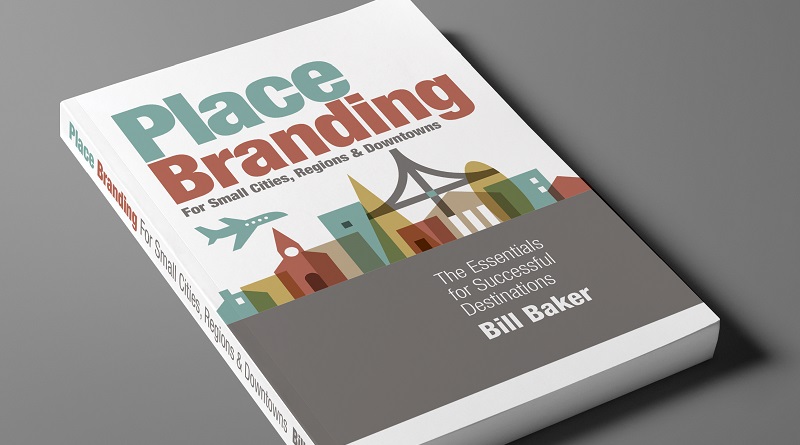It’s books like Bill Baker‘s ‘Destination Branding for Small Cities’, Robert Govers‘ ‘Imaginative Communities‘ or Andrew Hoyne‘s ‘The Place Economy‘ which breathe life into the complex topic of “place branding”: books written or edited by practitioners with many years of experience – keen to make place branding understandable and useful for the many community leaders, planners and marketers out there facing the task of strengthening their place’s offerings, identity and image.
With his latest book, ‘Place Branding for Small Cities, Regions and Downtowns’, Bill Baker has created a handy guide on place branding. I caught up with Bill to find out about his motivations of writing the book, how it differs from his previous book and his thoughts on the current state of place branding practice.
Bill, with ‘Place Branding for Small Cities, Regions and Downtowns’ you present a hands-on guide filled with essential know-how for the successful branding of destinations. Is the book very different from its earlier versions?
This is a new, updated edition, but it has also been expanded to take account of the ways that place branding is evolving. While I have again included hands-on techniques, checklists and real-world examples for smaller locations, I’ve also explored the changing scope and new influences, including the fusion of tourism, economic development, placemaking, and wayfinding. In other words, it’s time to knock down the silos and find a bigger table to engage all of those in the community who can be involved in communicating, developing, and delivering the brand.
When conducting interviews and research, I found several trends reshaping the practice, as well as the changing scope and dynamics of place branding. The book includes passages on how place branding must embrace changes, as diverse as technology, consumer behavior, placemaking, urban design, organization roles, sustainability, an experiential focus, more engaged citizens, the need for greater innovation, and more. At the same time, it shows how small places must fit into this louder and more crowded world.
Among the additions are:
- An examination of why many place branding efforts are doomed before they start
- Ways to bring a community’s brand to life through storytelling, experience design, placemaking and wayfinding
- Consideration of why branding is more important than ever in the Digital Age
- Insights from some of the world’s leading place branding consultants, academics and practitioners, many are members of the TPBO Expert Panel
- Reviewing how small towns and downtowns can tap into their DNA
- Exploring why imaginative places attract more talented workers
- Inspiring examples from the USA, Asia, Europe, Middle East, and Australia.
Why are you putting so much effort into making your many years of place branding experience and insights available in the form of the book?
So much of the everyday work by our team has always been about education and building the capacity of our clients in small cities.
As you indicated, my last books were best sellers (in their category) and are now out of print. After receiving encouragement and many requests for an update from individuals and distributors, I decided to write a new edition. I have to say that these books have been a labor of love, as I am sure that all books are for their authors.
Once I started, I became fascinated by the changing landscape, and this drove me.
While there has been a lot of progress, many place branding efforts continue to fail because of their limited focus on just a logo and tagline. That probably sounds like old news, but it’s a reality with many small city and regional efforts. I hope this book can provide some clarity and contribute to a more holistic approach.
Which changes have you witnessed since publishing your last book, in how city and destination branding is approached in the USA, and the world?
We have seen a greater realization within an increasing number of communities that there is very positive synergy between tourism, economic development, the attraction of talented workers and the lifestyle of a place that can be improved by bringing key players to the table. It showed that a place brand could provide a strategic framework to facilitate this.
It’s great to see that in some cases, place branding is increasingly likely to engage urban planners, architects, and placemaking specialists, as readily as tourism and economic development marketers. These enlightened communities realize that making brand promises that aren’t delivered is just hype. It takes the “village” to fulfill a community’s brand promise.
The application of place branding is gaining ground in terms of the types of places, professions, and organizations employing it. In an increasing number of cities, branding discussions are moving to the “big table” and gaining added credibility, empowerment, and resources.
It’s encouraging to see some new firms and agencies coming to the fore who are making positive contributions for their clients. But unfortunately, few of them are focused on smaller cities. Too many communities are still investing in superficial efforts that do not treat branding as strategic and are stuck in the tagline and logo syndrome.
Among the many cases which you have worked on recently and present in the book, which ones do you find the most remarkable?
Firstly, I must preface my comments by saying that place branding can be a perilous journey. Some places do a great job with defining their brand identity, but soon falter or fail when it comes to deployment and brand management, and the consistency needed to follow the agreed strategy. Others are unable to sustain the leadership, funding, personnel, and enthusiasm required to succeed. For these reasons, I’d like to point to the efforts of a few destinations that have passed the deployment stage and are into long-term management.
The first is the Yakima Valley in Washington State, who we worked with more than a decade ago. They have continued to keep their brand fresh and relevant through innovative communication and product development initiatives to build a distinctive brand identity that enables them to stand out from other Washington State wine regions.
For many places, there is a temptation to stray from the agreed strategy and guidelines. This is sometimes too much for some to resist. However, it’s great to see The Tillamook Coast in Oregon has creatively and consistently managed the deployment of their brand. Their focus on marketing communications has been mirrored by their investments in product experience development through grant programs linked to brand identity.
During my research, I was intrigued by how some small, hard-pressed communities were very entrepreneurial and innovative with the “cards” they were dealt. A great example is how Clarksdale, Mississippi (population of 17,962), has been re-energized after decades with a run-down downtown. This decline was due to big-box retailing and developments on the edge of town. Combined with the loss of jobs and population associated with agriculture, the town’s fortunes were in decline. However, the town’s rich heritage with Blues music and the culture that flows through the Mississippi Delta have been the foundation for its revitalization and fresh identity.
Clarksdale laid claim to its heritage related to the more than four dozen significant music artists that came out of Clarksdale; a half dozen is in the Rock and Roll Hall of Fame. They included Muddy Waters, John Lee Hooker, Ike Turner, and Sam Cooke, and many others who spent time being influenced and growing their careers locally. Clarksdale’s Walk of Fame and the Rock and Blues Museum salutes bluesmen like Sam Cooke, Muddy Waters, and ZZ Top, individuals who’ve made significant contributions, to its history.
Looking forward, which trends do you witness that might affect the capacity and ability of small towns, regions, and neighborhoods to be more imaginative in how they foster community spirit and represent themselves to the world?
After several decades, I am disappointed to say that a lack of community understanding about place branding, particularly among key leaders, is still “The Waterloo” or graveyard of too many small city branding initiatives.
Unless staff and committees can get beyond thinking in terms of logos and taglines, or mistaking a snappy campaign theme for a brand, and start considering a place brand as a strategic guidance system or rallying point, then their efforts will likely continue to fail.
It doesn’t matter how good the deliverables from a place branding agency may be, if the client’s staff, Board, committee members, partners, and stakeholders don’t understand what it is, its benefits, and how to manage it, then there’s a big chance their efforts will fail to gain traction.
These misunderstandings aren’t helped by aggressive salespeople representing agencies that themselves do not understand place branding, but shower unsuspecting communities with overblown promises of Nike-like brand awareness or promise them that social media dominance alone will create their brand.
While it’s likely that the place and destination marketers in communities may get it, it’s highly likely that many committee members and stakeholders in those same small cities and downtowns are encountering place branding for the first time. If they have no previous in-depth experience with place branding or even marketing, they may be at a disadvantage and possibly risk wasting public funds.
Their levels of knowledge and understanding can even impact agreeing on the original scope of work and judging the merits of the methodology to be adopted and the capability of prospective consultants and firms. To the uninformed, they may all look alike. Many of these efforts are doomed before they even reach the starting line.
It’s essential for everyone to be aware of what branding is and isn’t. Successful and sustainable brands are built from the inside out, and that starts from the earliest days before the project begins through outreach, engagement, and education. So, Florian, I guess what I’m saying is that TPBO has a lot more work ahead!
Indeed… anything else you’d like to mention?
The other big news is that my company, Total Destination Marketing will become part of Axia Creative. This follows our decade of fruitful collaboration and more fully blends TDM’s place branding credentials with Axia’s outstanding design, wayfinding, and environmental design capabilities. It will also enable me to increase my focus on working internationally on advancing place branding and increasing understanding of it among small cities, universities, and associations.
Thanks, Bill – and all the best!
Place branding for small cities, regions and downtowns is now available through Amazon. More about Bill Baker’s work in our interview – or find out how he can support your event as speaker.


